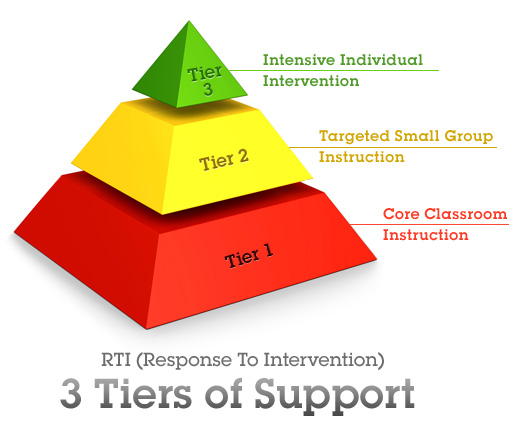What is RTI?
RTI stands for Response to Intervention and is a general approach that can be used within any academic area but the main focus typically lies with ELA and mathematics. RTI aims to identify students that may be struggling with a specific skill and/or content area and aid them in developing a better understanding through different level of instructional interventions. RTI relies heavily on collecting data and monitoring the progress of individual students to guide informed decision making about the level of instruction that would benefit students.
Four Main Functions of RTI
1. Identify students who are struggling academically
2. Document student performance
3. Determine the adequacy of each student's response to instruciton in order to decide on and appropriate level of instrucional intensity
4. Guide Instruction
Tiers of Intervention
1. Identify students who are struggling academically
2. Document student performance
3. Determine the adequacy of each student's response to instruciton in order to decide on and appropriate level of instrucional intensity
4. Guide Instruction
Tiers of Intervention

RTI Consist of the following tiers of intervention (supports for students):
Tier 1: Class or School-Wide Intervention is high-quality instruction that is received by all students in a classroom. Students will receive frequent progress monitoring of their academic skills through various informal and formal assessments. If a student(s) do not meet desired benchmarks with a certain skill(s) or within a specific content, they may be referred for tier 2 interventions.
Tier 2: Targeted Intervention is the same high-quality instruction in the classroom with peers as they receive in tier 1, but will also receive additional more intensive instruction in a small group setting. This small-group setting typically lasts between 10 and 20 weeks and focuses on the specific skill or skills that a student displayed struggles with in tier 1. Similarly to tier 1 instruction, the students will track growth with frequent progress monitoring. Students that appear to show minimal growth at tier 2, may be referred to tier 3 instruction.
Tier 3: Intensive, Individualized Intervention means students will receive the same in-class instruction with peers at tier 1 and also receive individual instruction in an alternative classroom with a teacher at another time during the day.
Downloads


